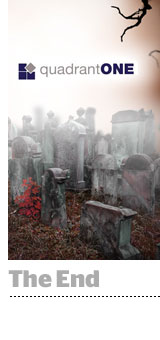 QuadrantONE, a joint venture of newspaper companies that sought to pool inventory resources and capitalize on the programatic selling opportunity, has shut down.
QuadrantONE, a joint venture of newspaper companies that sought to pool inventory resources and capitalize on the programatic selling opportunity, has shut down.
In a note posted to its website today, the company said its joint owners — The New York Times Co., Tribune Company, Hearst and Gannett – will pursue “different paths” for U.S. display advertising.
One cause, according to sources, was bickering among JV partners, including over the investment they would be willing to contribute to the company going forward.
Two years ago, QuandrantOne CEO Mario Diez was hopeful as the joint venture had just started a private exchange with AdMeld (later owned by Google). As he told AdExchanger at the time, “quadrantONE’s owners/partners have shown an exceptionally forward thinking outlook and meaningful commitment to the growth and success of the organization from the start.”
The disintegration could – in part – be attributed to growing internal programmatic strategies that create better yield than the assumed scale of the co-operative. Also, this may be a sign that exchanges are creating better yield these days. Why manage a separate exchange when you can go through existing exchanges such as Google’s DoubleClick Ad Exchange, PubMatic, Rubicon Project, AppNexus and so on, and receive comparable or better CPMs.
Finally, today’s technology enables private marketplaces and exchanges for publishers that set up various flavors of direct deals. The thinking might be that the buy side can use its tech to tie together reach and scale across the big publishers. Why do the heavy lifting – especially when they’re looking for specific audience versus placement?
To say that context doesn’t matter would be going too far though – context remains an important attribute that the buy side considers when addressing audience.
The abrupt shut down comes just before the joint venture’s five-year anniversary. It is expected to affect 30 to 40 employees. In the notice posted to its website, QuandrantONE said,
“To all of our valued partners:
As a result of the many changes that have occurred in the digital advertising marketplace over the last several years, the owner companies of quadrantONE have decided to seek different paths for national display advertising. As a result, quadrantONE will wind down current operations.
We’d like to take this opportunity thank all of our affiliate and advertising partners who have worked with us over the last 5 years. It has simply been our pleasure to serve you.
Sincerely,
The quadrantONE Team”
The website directs ad partners to an email address, transition@quadrantone.com. Speaking with AdExchanger in July 2012, CEO Mario Diez said, “The enormity of intelligence the news publishing industry routinely gathers is an asset that is yet to be fully realized. When combined with trusted and branded environments that go deep into local markets, we’re able to create tremendous opportunities to help brands localize their national strategy.”
John Ebbert and Zach Rodgers contributed.













